
Samhain was an Irish theatrical periodical published irregularly, with an annual in December. The Irish poet W. B. Yeats was a regular and leading contributor of essays outlining his artistic principles. It existed between 1901 and 1908.

Samhain was an Irish theatrical periodical published irregularly, with an annual in December. The Irish poet W. B. Yeats was a regular and leading contributor of essays outlining his artistic principles. It existed between 1901 and 1908.
Samhain was established in 1901. [1] Publication began in October 1901, superseding Beltaine, [1] an occasional theatre review and publication of the Irish Literary Theatre named for the ancient Irish festival Bealtaine. The Irish Literary Theatre published Samhain. [2] It has been noted that the two periodicals "constitute at once a history and a running critical commentary … of the origin and growth of the dramatic activity in Ireland." [2]
In the first issue of Samhain, Yeats explained the name change as referring to "the old name for the beginning of winter, because our plays this year are in October, and because our Theatre is coming to an end in its present shape." Samhain also published the texts of new plays for a time, but later these were printed in book form as The Abbey Theatre Series. It supported the poetic drama. [1] The magazine was published in Dublin by Sealy, Bryers & Walker, and in London by T. Fisher Unwin.[ citation needed ]
In 1908 Samhain ceased publication. [1]

William Butler Yeats was an Irish poet, dramatist and writer, and one of the foremost figures of 20th-century literature. He was a driving force behind the Irish Literary Revival, and along with Lady Gregory founded the Abbey Theatre, serving as its chief during its early years. He was awarded the 1923 Nobel Prize in Literature, and later served two terms as a Senator of the Irish Free State.
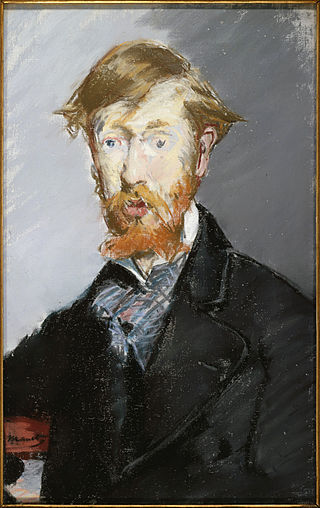
George Augustus Moore was an Irish novelist, short-story writer, poet, art critic, memoirist and dramatist. Moore came from a Roman Catholic landed family who lived at Moore Hall in Carra, County Mayo. He originally wanted to be a painter, and studied art in Paris during the 1870s. There, he befriended many of the leading French artists and writers of the day.
This article contains information about the literary events and publications of 1824.

The Abbey Theatre, also known as the National Theatre of Ireland, in Dublin, Ireland, is one of the country's leading cultural institutions. First opening to the public on 27 December 1904, and moved from its original building after a fire in 1951, it has remained active to the present day. The Abbey was the first state-subsidized theatre in the English-speaking world; from 1925 onwards it received an annual subsidy from the Irish Free State. Since July 1966, the Abbey has been located at 26 Lower Abbey Street, Dublin 1.

Isabella Augusta, Lady Gregory was an Anglo-Irish dramatist, folklorist and theatre manager. With William Butler Yeats and Edward Martyn, she co-founded the Irish Literary Theatre and the Abbey Theatre, and wrote numerous short works for both companies. Lady Gregory produced a number of books of retellings of stories taken from Irish mythology. Born into a class that identified closely with British rule, she turned against it. Her conversion to cultural nationalism, as evidenced by her writings, was emblematic of many of the political struggles that occurred in Ireland during her lifetime.
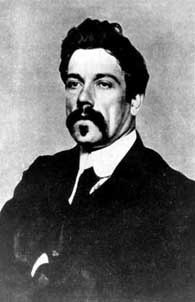
Edmund John Millington Synge was an Irish playwright, poet, writer, collector of folklore, and a key figure in the Irish Literary Revival. His best-known play The Playboy of the Western World was poorly received, due to its bleak ending, depiction of Irish peasants, and idealisation of patricide, leading to hostile audience reactions and riots in Dublin during its opening run at the Abbey Theatre, which he had co-founded with W. B. Yeats and Lady Gregory. His other major works include In the Shadow of the Glen (1903), Riders to the Sea (1904), The Well of the Saints (1905), and The Tinker's Wedding (1909).
The Irish Literary Revival was a flowering of Irish literary talent in the late 19th and early 20th century. It includes works of poetry, music, art, and literature.

Padraic Colum was an Irish poet, novelist, dramatist, biographer, playwright, children's author and collector of folklore. He was one of the leading figures of the Irish Literary Revival.
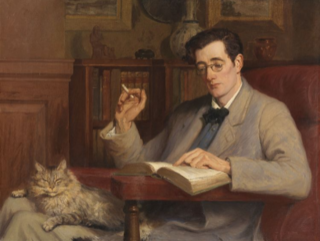
Esmé Stuart Lennox Robinson was an Irish dramatist, poet and theatre producer and director who was involved with the Abbey Theatre.
W. B. Yeats, Lady Gregory and Edward Martyn published a "Manifesto for Irish Literary Theatre" in 1897, in which they proclaimed their intention of establishing a national theatre for Ireland.

Katharine Tynan was an Irish writer, known mainly for her novels and poetry. After her marriage in 1893 to the Trinity College scholar, writer and barrister Henry Albert Hinkson (1865–1919) she usually wrote under the name Katharine Tynan Hinkson, or variations thereof. Tynan's younger sister Nora Tynan O'Mahony was also a poet and one of her three children, Pamela Hinkson (1900–1982), was also known as a writer. The Katharine Tynan Road in Belgard, Tallaght is named after her.

Elizabeth Corbet Yeats, known as Lolly, was an Irish educator and publisher. She worked as an art teacher and published several books on art, and was a founder of Dun Emer Press which published several works by her brother W. B. Yeats. She was the first commercial printer in Ireland to work exclusively with hand presses.

The Dun Emer Press was an Irish private press founded in 1902 by Evelyn Gleeson, Elizabeth Yeats and her brother William Butler Yeats, part of the Celtic Revival. It was named after the legendary Emer and evolved into the Cuala Press.
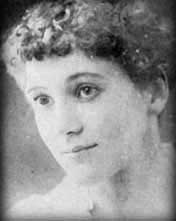
Florence Beatrice Emery was a British West End leading actress, composer and director. She was also a women's rights activist, journalist, educator, singer, novelist, and leader of the occult order, the Hermetic Order of the Golden Dawn. She was a friend and collaborator of Nobel laureate William Butler Yeats, poet Ezra Pound, playwright Oscar Wilde, artists Aubrey Beardsley and Pamela Colman Smith, Masonic scholar Arthur Edward Waite, theatrical producer Annie Horniman, and many other literati of London's fin de siècle era, and even by their standards she was "the bohemian's bohemian". Though not as well known as some of her contemporaries and successors, Farr was a "first-wave" feminist of the late 19th and early 20th centuries; she publicly advocated for suffrage, workplace equality, and equal protection under the law for women, writing a book and many articles in intellectual journals on the rights of "the new woman".

Cathleen ni Houlihan is a one-act play written by William Butler Yeats and Lady Gregory in 1902. It was first performed on 2 April of that year and first published in the October number of Samhain. Lady Gregory wrote the naturalistic peasant dialogue of the Gillane family, while Yeats wrote Cathleen Ni Houlihan's dialogue.
Diarmuid and Grania is a play in poetic prose co-written by George Moore and W. B. Yeats in 1901, with incidental music by the English composer Edward Elgar.
Allan Wade was a British actor, theatre director and writer.
Joseph Maunsell Hone was an Irish writer, literary historian, critic and biographer of George Moore and W. B. Yeats. He was one of the notable group of writers associated with the literary and theatre movement in Ireland in the early 20th century.
In the Faëry Hills, to which the composer gave the alternative Irish title An Suagh Sidhe, is a symphonic poem by Arnold Bax. It was composed in 1909 and was premiered in London in 1910. It is the second of three works that make up a trilogy of symphonic poems with the collective title Eire. The inspiration for the piece was The Wanderings of Oisin by the poet W. B. Yeats, whom Bax greatly admired.
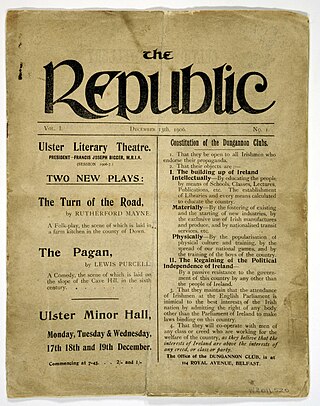
The Ulster Literary Theatre was a theatre company in Ulster from 1904 to 1934. It had a differently named precursor in 1902, and by 1915 it was named just the Ulster Theatre. It was founded by Bulmer Hobson and David Parkhill with patronage from Francis Joseph Bigger, who was also its first president.